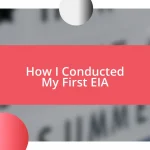Key takeaways:
- Engaging with local communities unveils invaluable insights and enriches Environmental Impact Assessments (EIAs) by incorporating lived experiences and cultural contexts.
- Methods such as informal interviews, community events, and participatory mapping foster genuine connections and empower residents to share their ecological knowledge.
- Integrating diverse perspectives, including emotional narratives and artistic expressions, enhances the credibility of EIAs and strengthens community trust and participation.
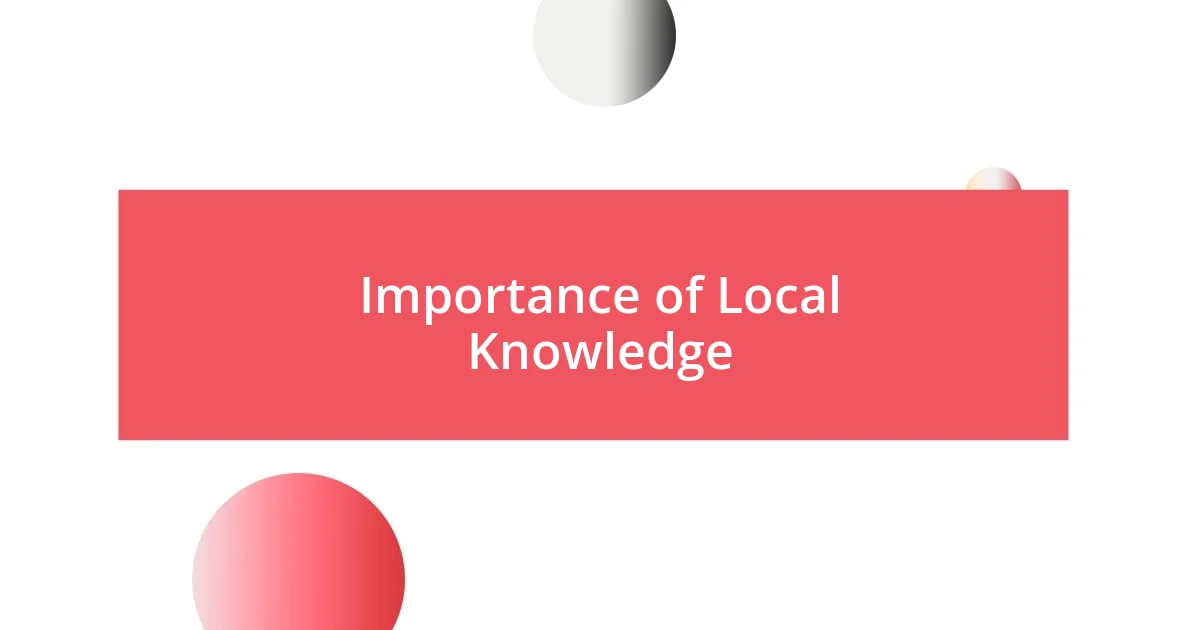
Importance of Local Knowledge
When I first worked on an Environmental Impact Assessment (EIA), I quickly discovered the undeniable value of local knowledge. Engaging with the community revealed insights about the land that no amount of academic research could have illuminated. Isn’t it fascinating how local people hold generations of wisdom about their environment?
I remember speaking to a fisherman who shared stories about seasonal fish migrations. His firsthand experiences highlighted shifts in patterns due to climate change, something I had only read about in reports. This level of detail not only enriched the assessment but also made me question: How much of our understanding relies solely on data, rather than the lived experiences of those who know the land intimately?
Local knowledge often brings cultural and historical contexts into the conversation, revealing connections that are deeply rooted in the community’s identity. This aspect reminded me of how crucial it is to view environmental impacts not just as abstract data points but as experiences that shape lives and cultures. How can we fully appreciate ecological assessments without honoring the voices and stories that give them life?
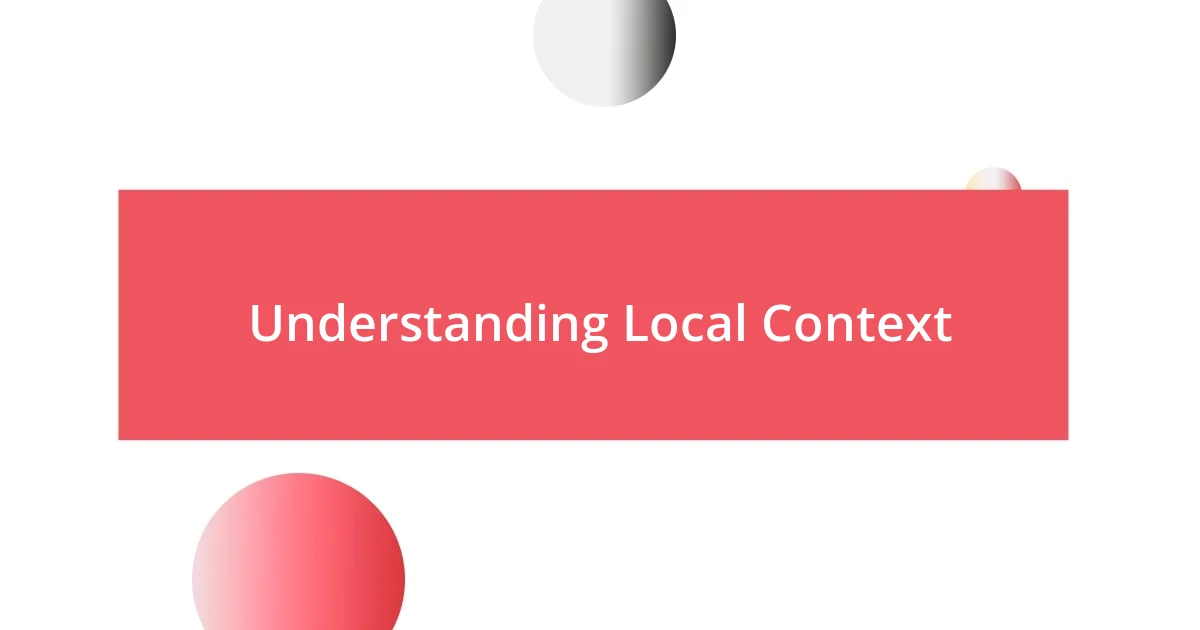
Understanding Local Context
Understanding the local context requires more than just a surface-level investigation; it calls for immersive engagement with the community. I vividly recall a time when I spent hours in a small village nestled near a river, listening to the elders discuss the changes they had observed over decades. Their accounts painted a picture far richer than any map or statistic could. It struck me how their knowledge was closely tied to their identity and traditions, showcasing just how essential it is to integrate these insights into EIA processes.
To grasp the local context effectively, consider these aspects:
- Cultural Practices: Understand how local traditions impact land use and resource management.
- Historical Context: Investigate past events that shape current environmental perceptions and practices.
- Community Dynamics: Recognize the roles various community members play in managing local resources.
- Ecological Knowledge: Gather insights about local flora and fauna and their significance to the community.
- Perceptions of Change: Discuss with residents their observations regarding environmental changes over time.
By weaving these dimensions into the EIA, I found that the assessments became more holistic and reflective of the real-world intricacies that influence local ecosystems.
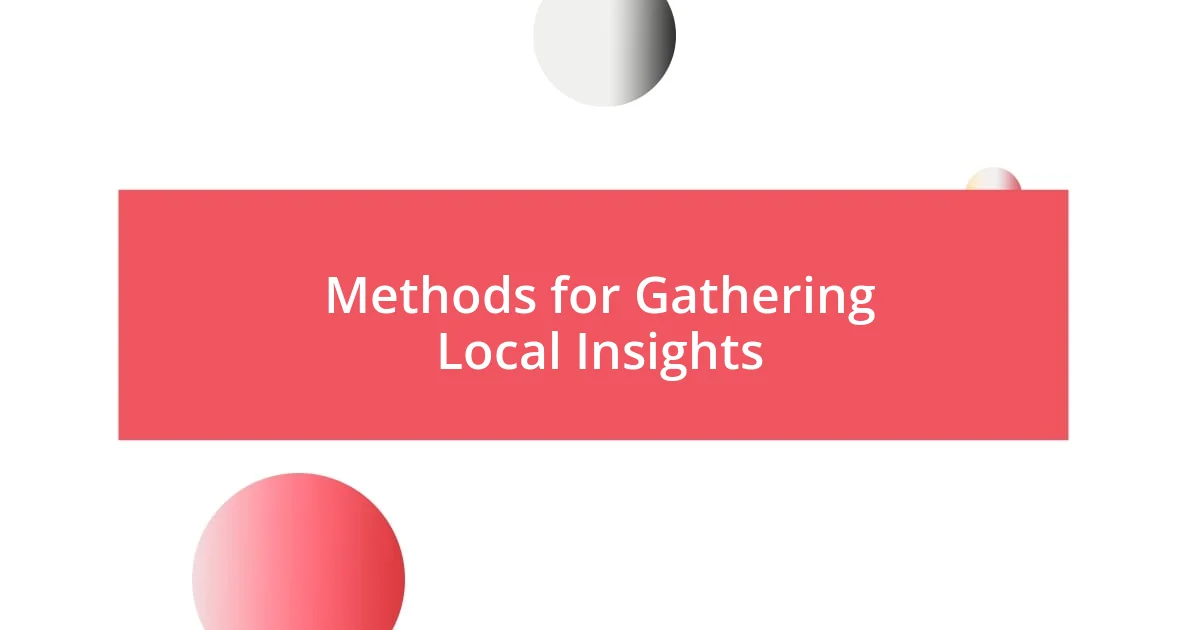
Methods for Gathering Local Insights
Gathering local insights can be approached through a variety of methods, each offering unique benefits. One technique I found particularly rewarding was conducting informal interviews with community members—like when I visited a local women’s group and shared laughter over past struggles. Their stories not only revealed their resilience but also illustrated how local practices, such as handmade crafts, tied closely to environmental stewardship. This kind of dialogue creates a genuine connection and helps uncover truths that statistics often gloss over.
Another effective method is participating in community events, such as festivals or environmental clean-ups. At one community event, I participated in a beach clean-up where I chatted with residents about their concerns regarding plastic pollution. Their passion and direct experiences highlighted specific areas where the EIA could be improved, making me realize that observing local efforts can offer invaluable insights that deepen the perspective of an EIA.
Moreover, utilizing participatory mapping exercises can visually capture local knowledge. In my experience, when residents were asked to map out areas of ecological significance, it sparked incredible discussions. They pointed out locations that mattered to them—places for fishing, gathering medicinal plants, or sites of historical importance. The resulting maps not only enhanced our understanding but also engaged the community in the EIA process, empowering them and making them feel integral to the project.
| Method | Description |
|---|---|
| Informal Interviews | Engagement with community members to gather personal stories and insights. |
| Community Events | Participation in local gatherings to observe and discuss environmental concerns. |
| Participatory Mapping | Collaborative creation of maps to highlight areas of cultural or ecological significance. |

Incorporating Knowledge into EIAs
Integrating local knowledge into Environmental Impact Assessments (EIAs) is a transformative process. I remember a particularly enlightening moment when I sat with fishermen by the shore, watching them mend their nets as they shared tales of declining fish populations. Their insights were not just statistics; they reflected a deep-rooted connection to the water and a cultural narrative rich with wisdom. How can one ignore such firsthand accounts when evaluating potential projects that impact their livelihoods?
In another scenario, during a community workshop, I encouraged residents to share their dreams for a sustainable future. One elderly woman stood up, her voice trembling with passion, and spoke about preserving a sacred grove that had been part of her family’s memories for generations. This emotional connection highlighted the necessity of considering not just the physical landscape but the emotional landscapes intertwined with it. It made me realize that local knowledge can unveil layers of significance that institutional data simply cannot capture.
Additionally, when I collaborated with local youth to document their environmental concerns through art, I saw their vibrant interpretations of the landscape. These young artists depicted pollution and habitat loss not only through paint but also through stories, showcasing their hopes for restoration and balance. It prompted me to reflect: how often do we risk overlooking the voices of those who will inherit the environment? Incorporating these diverse perspectives into EIAs helps foster a sense of ownership and responsibility among community members, ultimately leading to more effective and sustainable outcomes.
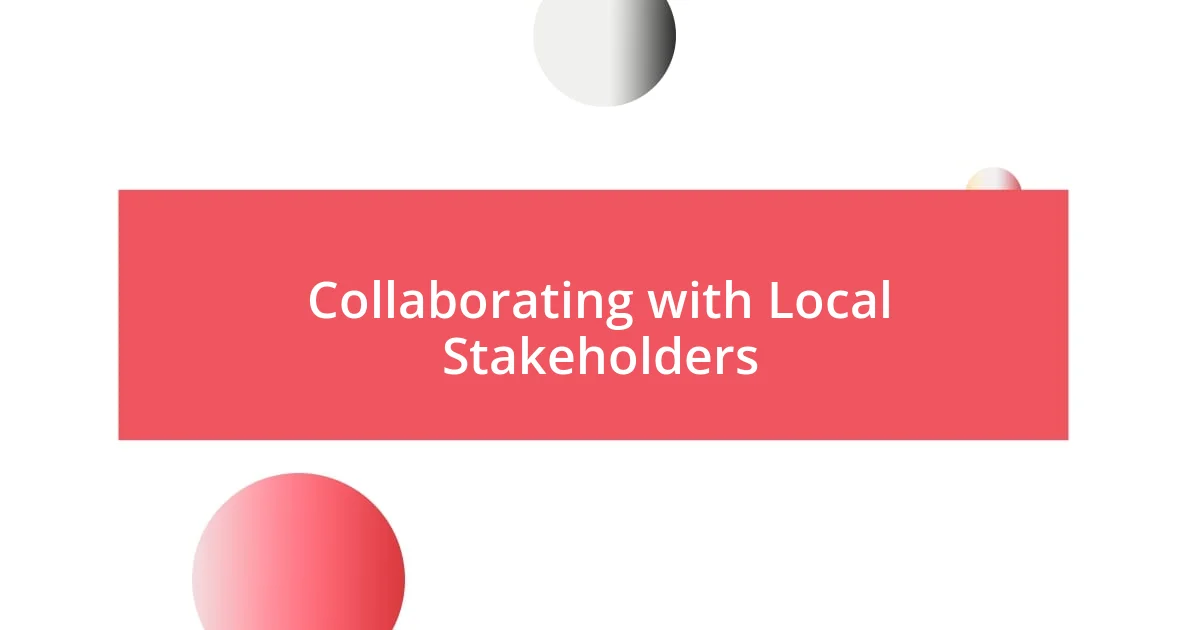
Collaborating with Local Stakeholders
Collaborating with local stakeholders is essential in creating a comprehensive Environmental Impact Assessment (EIA). I can recall a significant moment when I organized a community forum, inviting fishermen, farmers, and local elders to share their experiences. The atmosphere was electric with passion as they articulated their concerns about upcoming industrial developments. Their firsthand knowledge illuminated gaps in our understanding, making me realize that these conversations are not just formalities—they are foundational to crafting a true reflection of the community’s needs.
On another occasion, I partnered with a local school to engage students in discussions about their environmental observations. Their innocence and inquisitiveness opened my eyes to how deeply they cared for their surroundings, even urging their parents to implement more sustainable practices at home. It struck me—how often do we underestimate the power of the younger generation? These interactions not only fostered trust and dialogue but also made the kids feel valued as stakeholders in the process, ensuring that their voices would not be overlooked.
I also remember a particular moment when a local artist joined our discussions, illustrating the community’s fears and hopes through striking murals. The imagery spoke volumes, conveying emotions that words sometimes fail to capture. This artistic collaboration reminded me how vital it is to incorporate diverse expressions of local knowledge, as they can truly resonate with the core of the community’s values. Such partnerships not only enrich the EIA but also build a shared vision for a sustainable future, where everyone feels a part of the journey.

Evaluating the Impact of Integration
Evaluating the impact of integrating local knowledge into EIAs has been an eye-opening experience for me. In one project, I vividly recall sitting down with a group of local artisans whose craft is intricately tied to the landscape. As they shared their stories about how changes in water levels affected their clay sources, I couldn’t help but think: how many assessments overlook this connection? It became clear to me that these insights were not mere anecdotes; they held the power to reshape our understanding of potential risks and benefits.
During a recent evaluation process, I also experimented with mapping local narratives alongside scientific data. I engaged community members to pinpoint areas of importance on a map while sharing personal stories related to those places. The juxtaposition was striking. What stood out to me was how these rich narratives added depth to our analysis, allowing us to identify potential impacts that quantitative data alone would have missed. It reminded me that the human experience is often the missing variable in assessments.
In the end, the feedback I received after presenting our findings was overwhelmingly positive. Many community members expressed gratitude for finally seeing their voices reflected in the assessment. It left me pondering: how often do we create spaces for people to contribute their experiences meaningfully? This integration not only enhanced the credibility of the EIA but also fostered trust and participation, making the community feel like co-creators rather than mere subjects of a study.

Case Studies of Successful Integration
In one notable case, I collaborated with a local indigenous group in a coastal area facing development pressures. They shared their deep-rooted knowledge about local tides and marine species, which painted a picture of the ecosystem that was quite eye-opening. I found myself asking, how many times do we overlook such essential ecological insights simply because they come from traditional practices? Integrating their knowledge transformed our EIA, providing invaluable context that scientific data alone couldn’t deliver.
Another instance took place in a rural agricultural community where I facilitated workshops that allowed farmers to express their concerns over changing climate patterns. As they shared personal stories about crop failures and shifting rainfall, I could see their frustration and fear for the future reflected in their faces. This visceral connection made me realize that each data point in our analysis was not just a statistic; it represented someone’s livelihood. When we factored in these narratives, the EIA evolved into a more holistic assessment, balancing empirical data with the very human stories behind it.
Then, I remember working on an urban project where community art played a crucial role. Local residents created a series of paintings depicting both their dreams for urban green spaces and their anxieties about environmental degradation. This artistic expression revealed sentiments that traditional surveys often miss. It left me pondering: are we truly listening when communities speak, or are we just waiting for our turn to respond? Including art in our EIA enriched our understanding of the community’s emotional landscape, ensuring that our recommendations resonated on a deeper level with those most affected.











